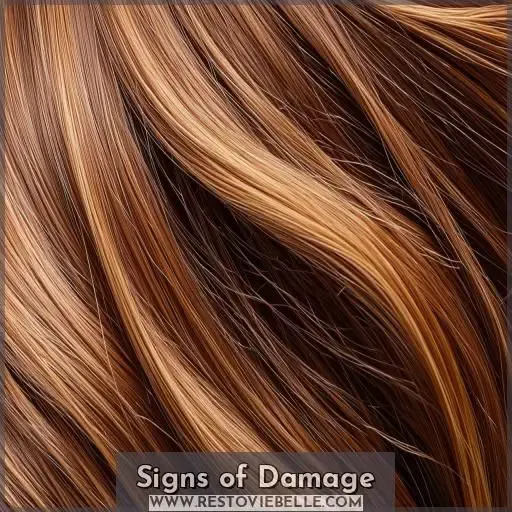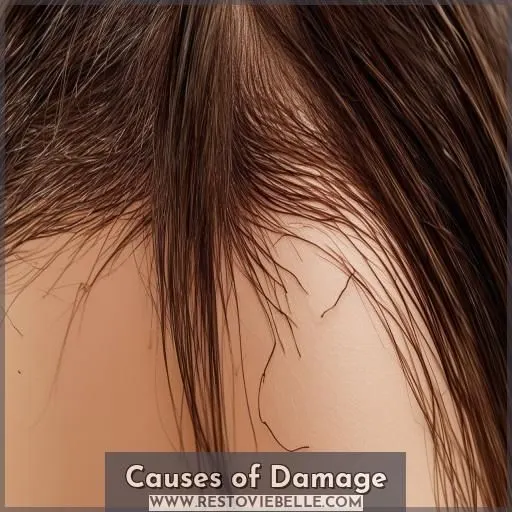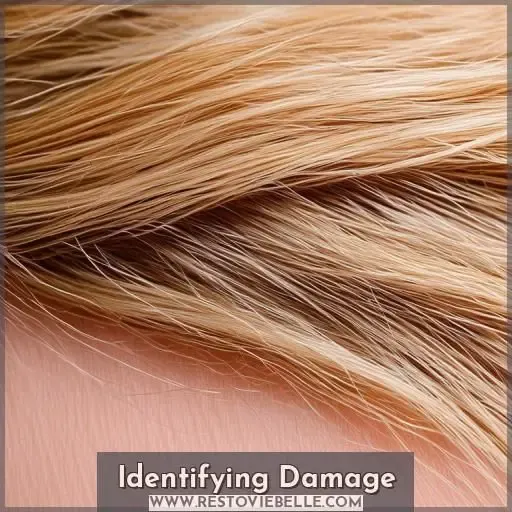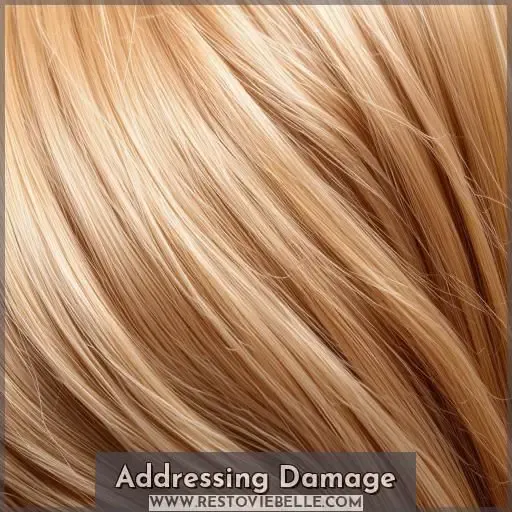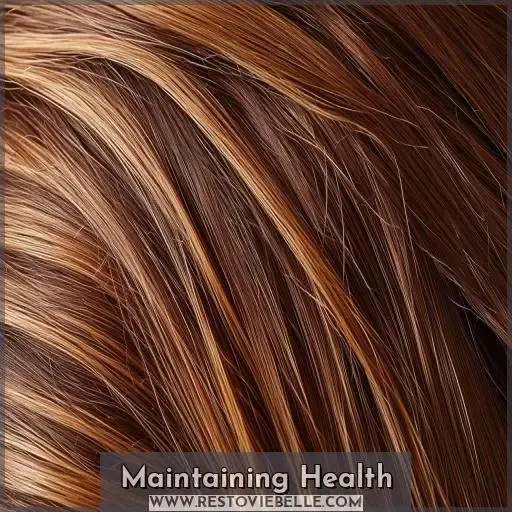This site is supported by our readers. We may earn a commission, at no cost to you, if you purchase through links.
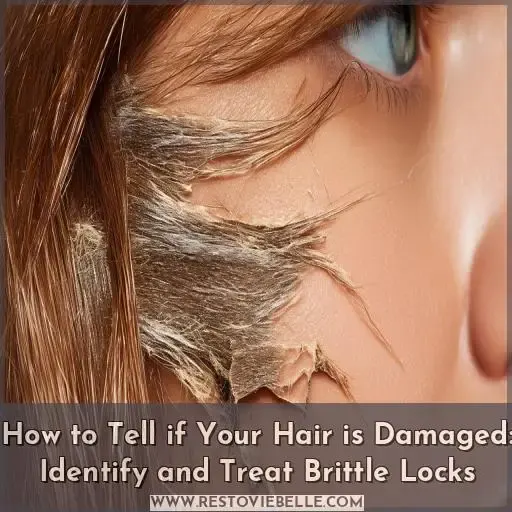 Tell if your hair is damaged by its appearance and feel. Look for dull, rough strands that snap easily – those are telltale signs.
Tell if your hair is damaged by its appearance and feel. Look for dull, rough strands that snap easily – those are telltale signs.
Give your locks a gentle tug – healthy hair stretches then bounces back, while brittle hair breaks. Check for split ends, those pesky frayed tips.
Excessive shedding and tangles can also indicate damage. If you’re unsure, do the "porosity test" – damaged hair absorbs water rapidly or struggles to get wet.
Don’t despair if your strands are in rough shape – you can revive them with the proper care. Stick around to discover how to nurse brittle locks back to health.
Table Of Contents
Key Takeaways
- Grab a lock of hair and give it a gentle tug – healthy hair will stretch and bounce back, while damaged locks will snap and break. It’s like a game of hair limbo – how low can you go before it calls it quits?
- Time for an end-game inspection! Gently run your fingers along your strands, feeling for rough, frayed split ends. Those pesky little splits are like a flashing neon sign screaming "Hair SOS!"
- If your locks are struggling to absorb moisture, it’s time for a porosity check. Spritz some water on your strands – if it beads up and refuses to drink, your cuticles are rolling out the unwelcome mat.
- Pay attention to excess shedding and tangles – it’s like your hair is staging a protest against your current routine. If you’re finding more strands in the drain than usual, your hair may be waving a white flag of surrender.
How to Tell if Your Hair is Damaged?
To tell if your hair is damaged, look out for signs like dry, brittle strands that break easily and split ends. Damaged hair often looks and feels rough, dull, and lifeless to the touch.
Signs of Damage
Are you noticing your hair looking dull, dry, and rough? Does it feel brittle and break easily? If so, your locks may be damaged.
Split ends, excessive shedding, and knots are telltale signs of hair in distress.
Damaged hair can result from environmental factors, chemical processing, over-styling, nutrient deficiencies, or hormonal changes.
Pay attention to these red flags – addressing hair damage early is key to reviving your strands’ health and shine.
Causes of Damage
Your hair can become damaged due to various factors like heat styling tools, UV exposure from the sun, chemical treatments like coloring or perms, hard water minerals, and poor hair care practices. Recognizing the causes of damage is important to prevent further harm and maintain healthy, luscious locks.
Heat Styling
You inadvertently singe strands with styling tools:
- Flat irons scorch hair shafts
- Blow dryers deplete moisture
- Curling irons cause brittleness
- Hot rollers rough up cuticles
Incorporate heat protectants to shield hair health.
UV Exposure
Sun exposure is another major hair damager. If you spend lots of time outdoors for activities or work, apply sunscreen to protect your strands from becoming dry, brittle, and prone to breakage. Wear hats or hair accessories for extra coverage.
Chemical Treatments
Chemical treatments can wreak havoc on your hair’s:
- Porosity (hair’s ability to absorb moisture)
- Elasticity (hair’s ability to stretch and recover)
- Cuticle condition (protective outer layer)
Bleach, dyes, perms, and color can cause irreversible chemical burns.
Hard Water
Hard water can wreak havoc on your locks due to mineral buildup that causes scalp irritation, brittleness, thinning, and dryness – a recipe for intense breakage.
Poor Hair Care
In addition to hard water, poor hair care practices like excessive brushing, over-conditioning, product buildup, inconsistent care routines, and improper drying techniques can wreak havoc on your strands’ porosity, elasticity, and cuticle condition.
Identifying Damage
Identifying damaged hair is essential for taking the proper steps to restore its health. The first step is to carefully examine your hair in the mirror, focusing on signs like dryness, split ends, and a rough texture; then, run your fingers through your locks to assess brittleness and tangling.
Visual Inspection
Like a detective, you’ll want to visually inspect for these telltale signs:
- Dullness and lack of shine
- Rough, frizzy texture
- Excessive split ends
- Visible breakage or thinning
Touch and Feel
Run your fingers through your strands – damaged hair feels rough, coarse and lacks elasticity. Healthy hair stretches and bounces back. Check porosity by misting hair, porous locks absorb moisture rapidly while resistant cuticles take time.
Split Ends
Inspecting your hair for splits is key. Gently run your fingers along strands, feeling for:
- Rough, frayed ends
- White, split tips
- Dry, brittle texture
- Frequent tangles or knots
Split ends signify damage – address them promptly.
Increased Shedding
You may also notice increased hair shedding, a sign of weakened follicles and breakage. Inspect fallen strands for:
| Strand Type | Implication |
|---|---|
| Short, Dry | Breakage |
| Bulb Intact | Normal Shed |
Addressing the root cause aids follicle health.
Scalp Irritation
Scalp irritation may signal damage—pay attention to redness, itching, or flaking. These signs indicate scalp sensitivity, often triggered by harsh products or styling habits. Seek gentle scalp treatments, home remedies, or a professional’s guidance to soothe inflammation.
Addressing Damage
If your hair is starting to feel dry, brittle, and prone to breakage, it’s time to address the damage. Using split end treatments, deep conditioning hair masks, gentle shampoos and conditioners formulated for damaged hair, as well as products that protect against heat and UV rays can help restore your locks’ health and shine.
Split End Treatments
One way to combat split ends is with home remedies. Here are 3 natural solutions:
- Egg mask: Mix 1 egg with olive oil and honey. Apply to ends.
- Avocado treatment: Mash ripe avocado, apply to split ends.
- Warm oil treatment: Heat coconut or argan oil, smooth onto ends.
Hair Masks
Try DIY hair masks: blend avocado, honey and olive oil for moisture. Eggs provide protein for strength. Natural masks nourish and repair damaged hair elasticity, porosity and cuticles.
Gentle Haircare
Switch to gentle, sulfate-free shampoos and conditioners that hydrate without stripping. Regularly deep condition, detangle with care, and massage your scalp to boost circulation and pliability. Adapting your routine to your hair’s porosity level is key for restoring manageability.
Heat Protection
When heat styling, use leave-in conditioners and thermal protectants. Minimize blow-drying and opt for these gentler techniques:
- Air drying when possible
- Using lower heat settings
- Applying heat-protective styling products
- Investing in ceramic brushes/tools
Your hair will thank you for the extra care!
UV Protection
UV rays can cause damage to your hair. Protect your locks from sun damage by wearing protective hats or applying hair sunscreens. Here’s a handy guide:
| Product | SPF | Benefits |
|---|---|---|
| Spray | 30+ | Light, non-greasy |
| Cream | 50+ | Rich, long-lasting |
| Serum | 15+ | Nourishing, UV filters |
| Powder | 30+ | Mattifying, easy reapplication |
| Mist | 20+ | Invigorating, perfect for beach days |
Shielding your strands from sunlight is key to maintaining their health.
Maintaining Health
To maintain healthy hair, you’ll want to avoid over-washing, which can strip your strands of their natural oils. Regularly combing with a wide-toothed comb, getting trims to prevent split ends, eating a nutrient-rich diet, and managing stress levels are also essential for keeping your hair looking and feeling its best.
Washing Frequency
To preserve your hair’s health, regulate washing frequency. 1) Avoid sulfate shampoos, 2) Use dry shampoos sparingly, 3) Rinse with cool water, 4) Condition every few days. Moderation is key – overwashing strips oils, while undercleaning allows buildup.
Combing Techniques
When combing, use a wide-tooth comb or detangler on wet hair to prevent breakage and tangles. Gently work from ends to roots, avoiding harsh tugging that damages strands and irritates the scalp.
Regular Trims
Get regular trims to remove split ends, promoting healthy hair growth. Frequent trims (every 6-8 weeks) maintain shape and remove damaged sections. Consider your hair type, texture, and style when determining trim frequency and technique (dusting, straight, or layered). Professional trims guarantee precision, but DIY trims save money.
Healthy Diet
Eating a nutrient-rich diet is key for healthy hair. Vitamins like biotin, iron, and protein support growth, while zinc and vitamin C boost oil production for shine. Avoid deficiencies by consuming greens, nuts, eggs, and lean meats to nourish your locks from within.
Stress Management
And don’t forget about managing stress—emotional upheaval can trigger hair-damaging spikes in stress hormones that lead to excessive shedding and thinning. Practice relaxation techniques like meditation, yoga, or deep breathing to keep your tresses looking their best.
Frequently Asked Questions (FAQs)
How to determine if hair is heat damaged?
Ah, the irony of heat-damaged hair – the very tool meant to tame becomes a torturer. Run your fingers through strands; roughness and dullness scream "enough!" Time to cool it on those hot tools.
What are the signs of chemical damage?
Signs of chemical damage include brittleness, excessive dryness, and discoloration. Your hair may feel gummy or mushy when wet, and you’ll notice increased breakage and split ends.
Can damaged hair lead to hair loss?
Hair loss? It’s like a bad breakup – you’ll shed tears over those lost strands. Sadly, yes, damaged hair can lead to excessive shedding and thinning. Neglecting those fragile locks is a recipe for baldness, my friend.
How often should you deep condition damaged hair?
You should deep condition damaged hair once or twice per week. This nourishes strands, restoring moisture and improving manageability. Be gentle – carefully detangle and let the mask penetrate.
Can hormonal changes cause hair damage?
As the saying goes, "Hair today, gone tomorrow" – yes, hormonal changes can wreak havoc on your luscious locks. From thyroid imbalances to pregnancy, hormonal shifts can lead to weakened, brittle hair prone to breakage and damage. Embrace the new you with proper care and patience.
Conclusion
Restoring your hair’s luster starts with identifying how to tell if your hair is damaged. Are your strands dry, brittle, and prone to breakage?
Implementing gentle care routines, protecting against heat and UV exposure, and using reparative treatments can revive lackluster locks.
Why settle for dull, damaged hair when you can achieve enviable shine and resilience?
Commit to nurturing your tresses – the path to a healthy mane begins today.
